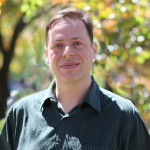Introducing Larne Pekowsky, Syracuse University’s Cyberinfrastructure Engineer (CIE)
Successful research requires a deep knowledge of one’s subject area and is often aided when the researcher is fluent with the available computing resources.  Without this working knowledge of computing technology, the process of applying the research problem to the appropriate computing resource is a daunting task! Fortunately, Larne Pekowsky; Syracuse University’s new Cyberinfrastructure Engineer (CIE) is coming onboard to help bridge this gap between researcher and resource.
Without this working knowledge of computing technology, the process of applying the research problem to the appropriate computing resource is a daunting task! Fortunately, Larne Pekowsky; Syracuse University’s new Cyberinfrastructure Engineer (CIE) is coming onboard to help bridge this gap between researcher and resource.
This position, funded through the National Science Foundation’s Campus Cyberinfrastructure – Data, Networking, and Innovation Program (CC*DNI), was created specifically to foster growth in research computing at Syracuse University. A key component of this new position will be interfacing with University researchers to better understand their needs and recommend the best available computing resources to meet their specific goals.
Coming from his previous roll as Computer Systems Specialist for Syracuse University’s Gravitational Wave Group, Larne is well versed in SU’s research computing services , including Crush, OrangeGrid, and the Academic Virtual Hosting Environment. This new position will provide an aggregation point for identifying common research computing needs, problems, and resources among the Syracuse University research community. Further, to foster a vibrant research community, the CIE’s connection between researcher and technology will interconnect the diverse set of existing campus research computing efforts.
If you would like to consult with Larne please contact him us!
Investment in campus cyberinfrastructure (CI) is essential to answering many of the most fundamental questions in science and engineering. Syracuse University has created a campus CI engineer position to provide the technical expertise and leadership to realize the potential of existing investments in CI and to guide strategy for future investments for research and education. Science drivers for the campus CI engineer come from a diverse range of projects including, gravitational-wave astronomy, biological physics, theoretical condensed matter physics, computational fluid dynamics, high-energy physics, Earth sciences, soft matter physics, and biomedical and chemical engineering. By allowing Syracuse researchers to better use CI, including research computing clouds, identity management services, networking, high-throughput computing, and high-performance computing, both on and off campus, the CI engineer allows Syracuse University researchers to advance scientific discovery.
Syracuse University’s campus cyberinfrastructure serves as an important resource for education of undergraduate and graduate students. An essential part of the CI engineer’s responsibilities is lowering the barriers to access to CI resources for beginning researchers. The CI engineer’s activities extend beyond engagement with the Syracuse campus, leading Syracuse University’s engagement with the national cyberinfrastructure community, and collaborating broadly across campuses on shared goals.
